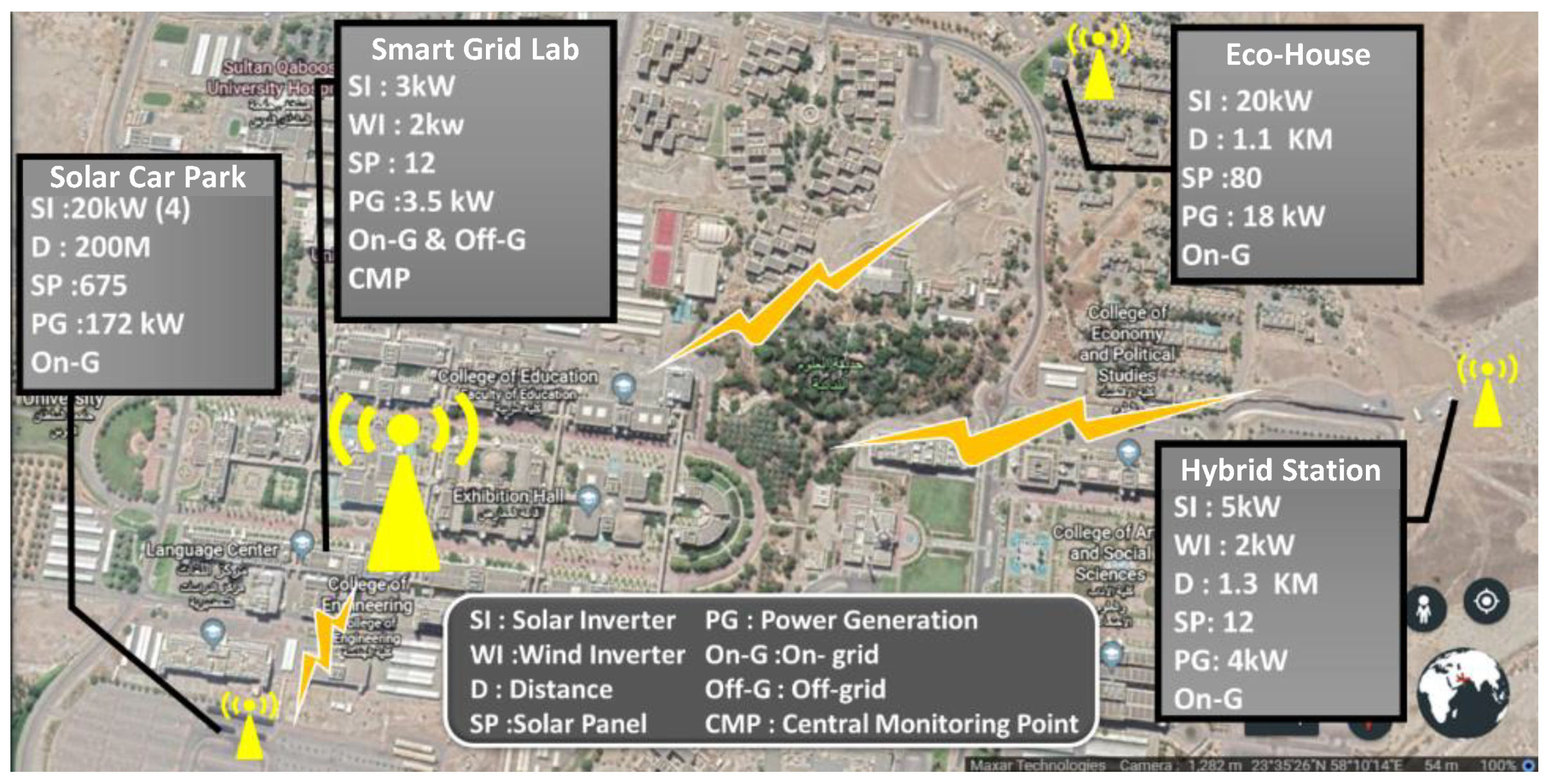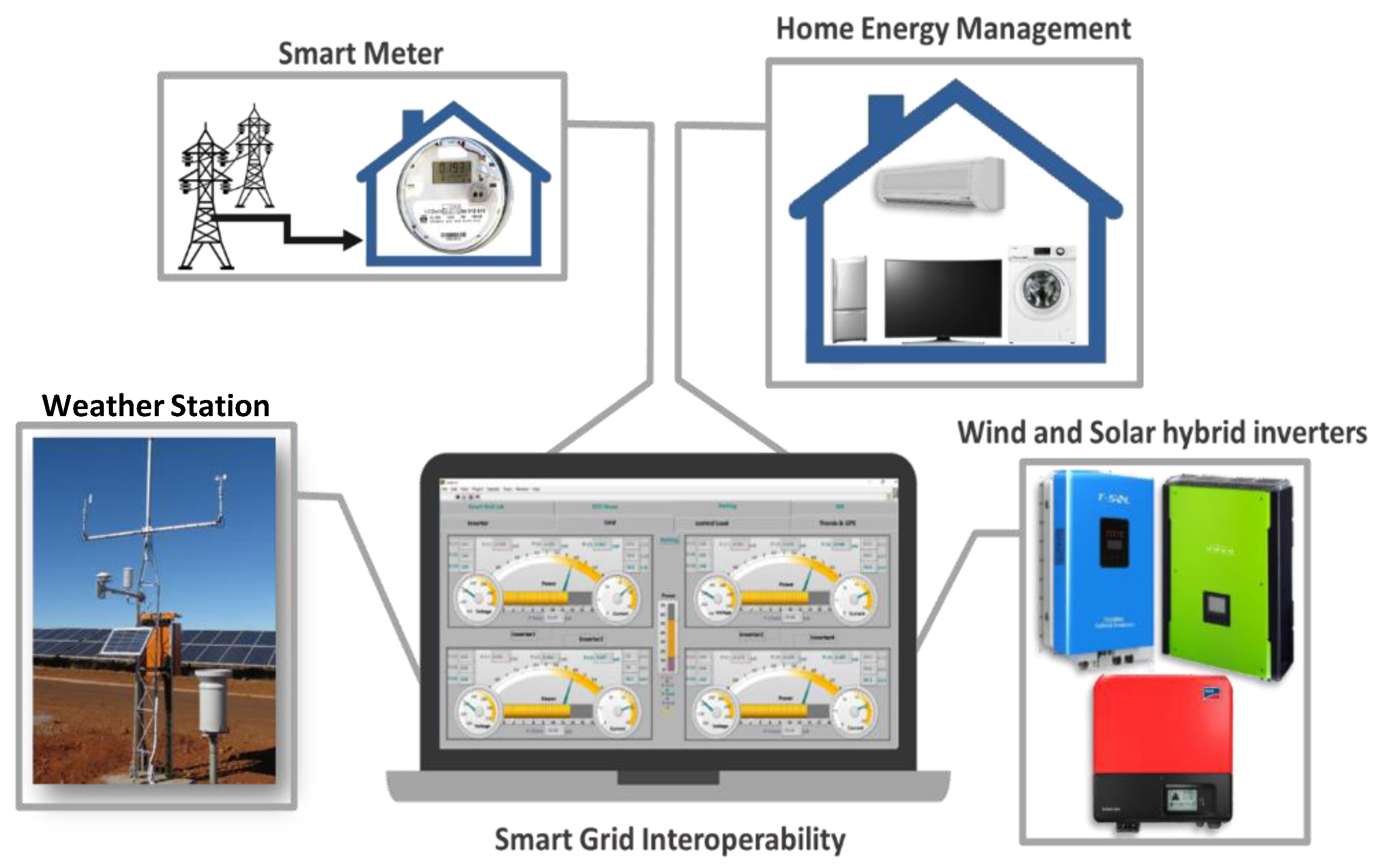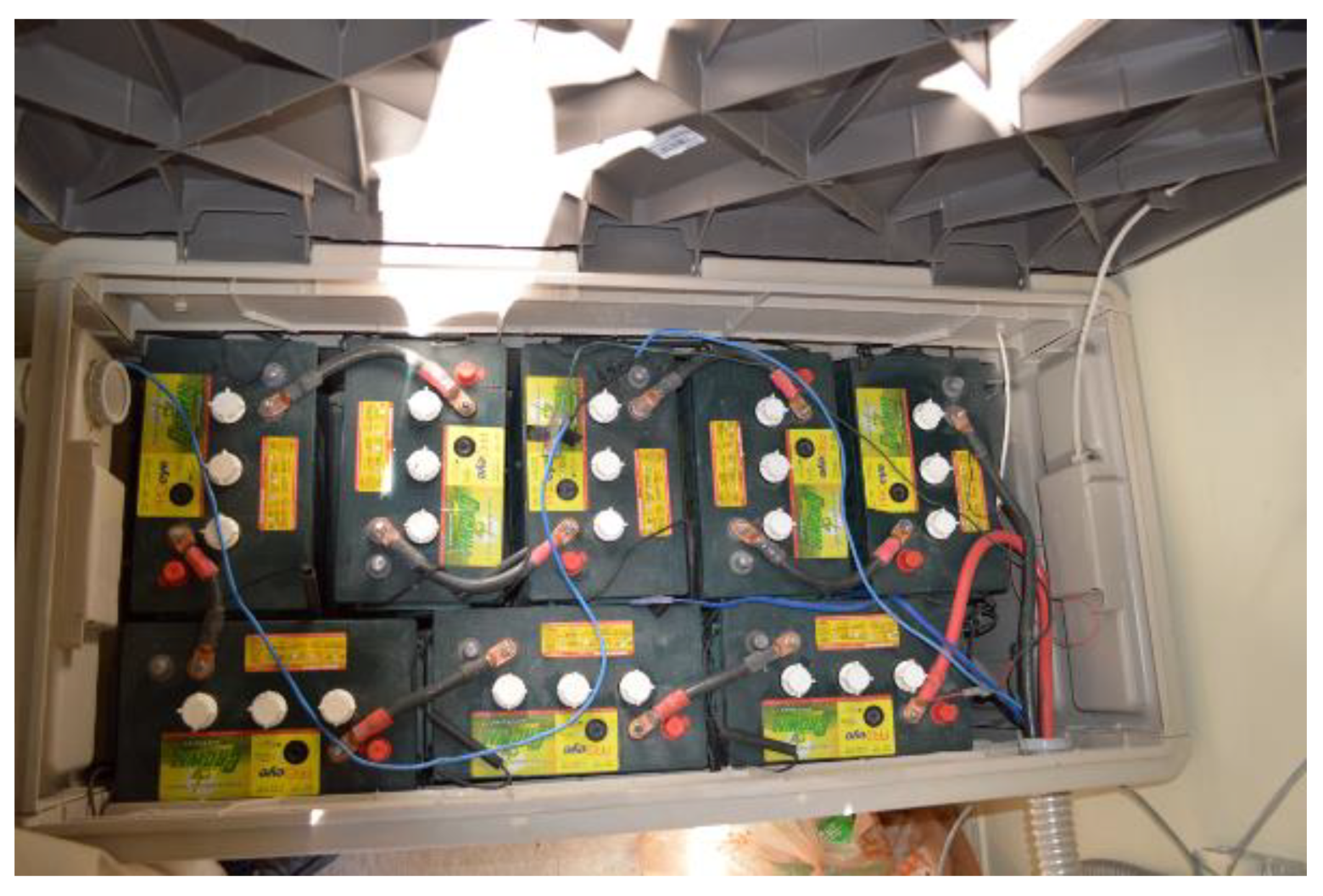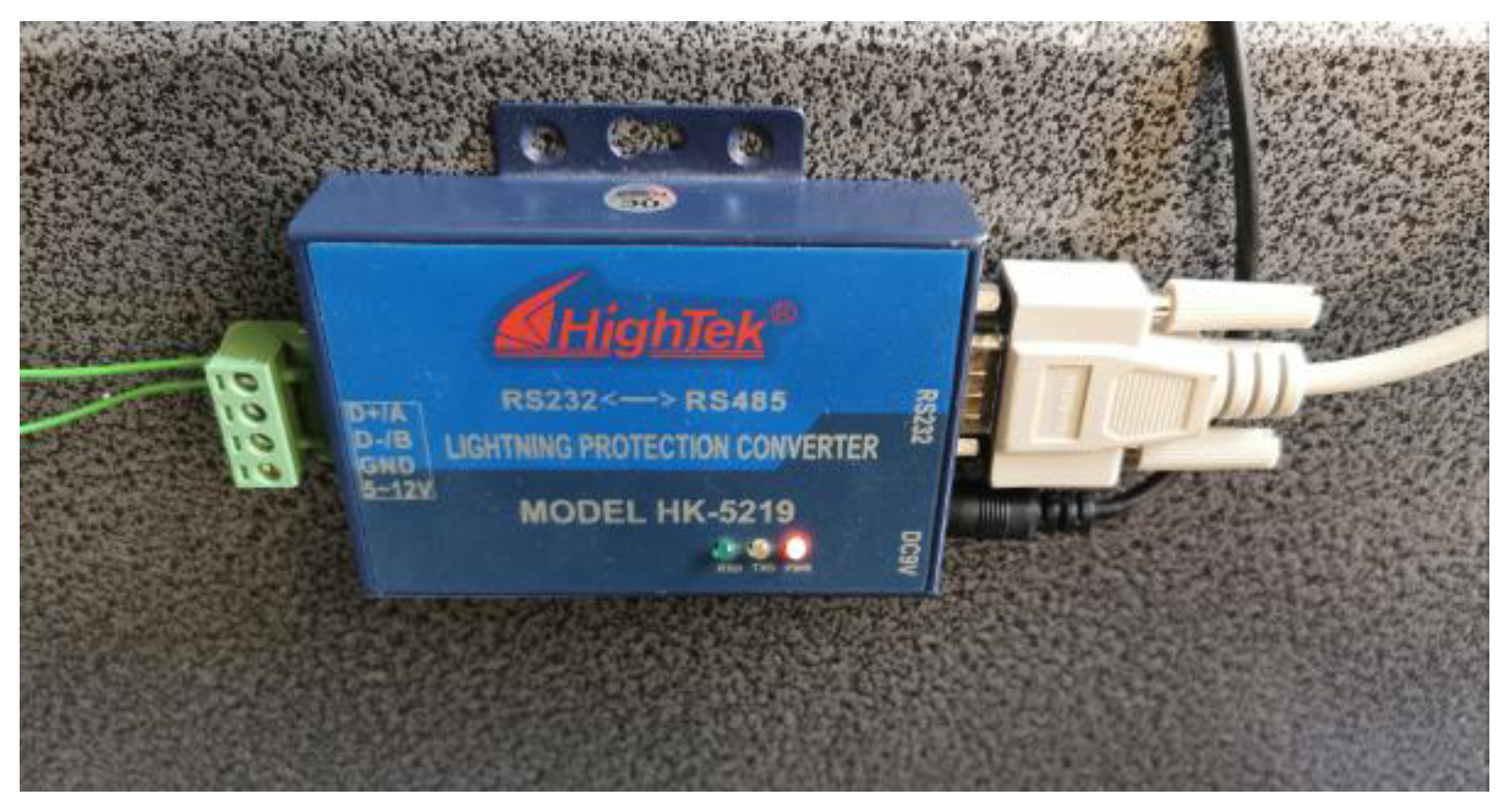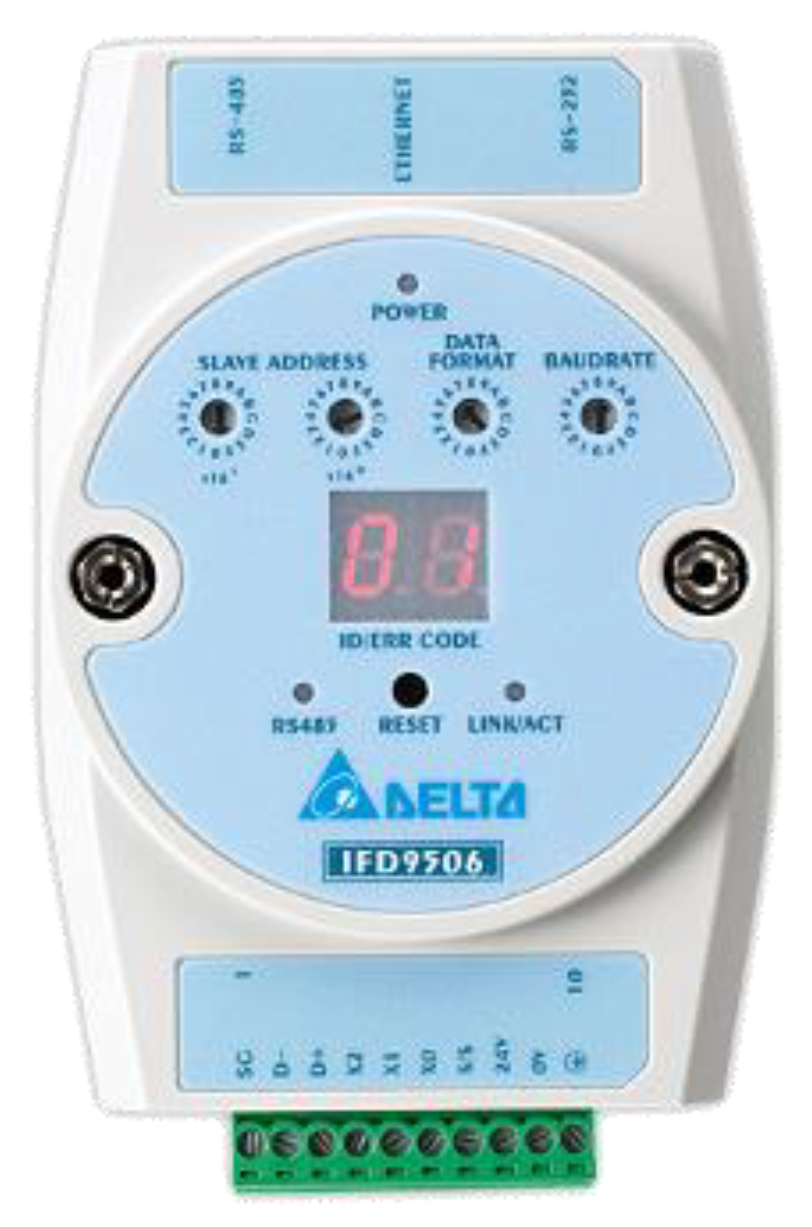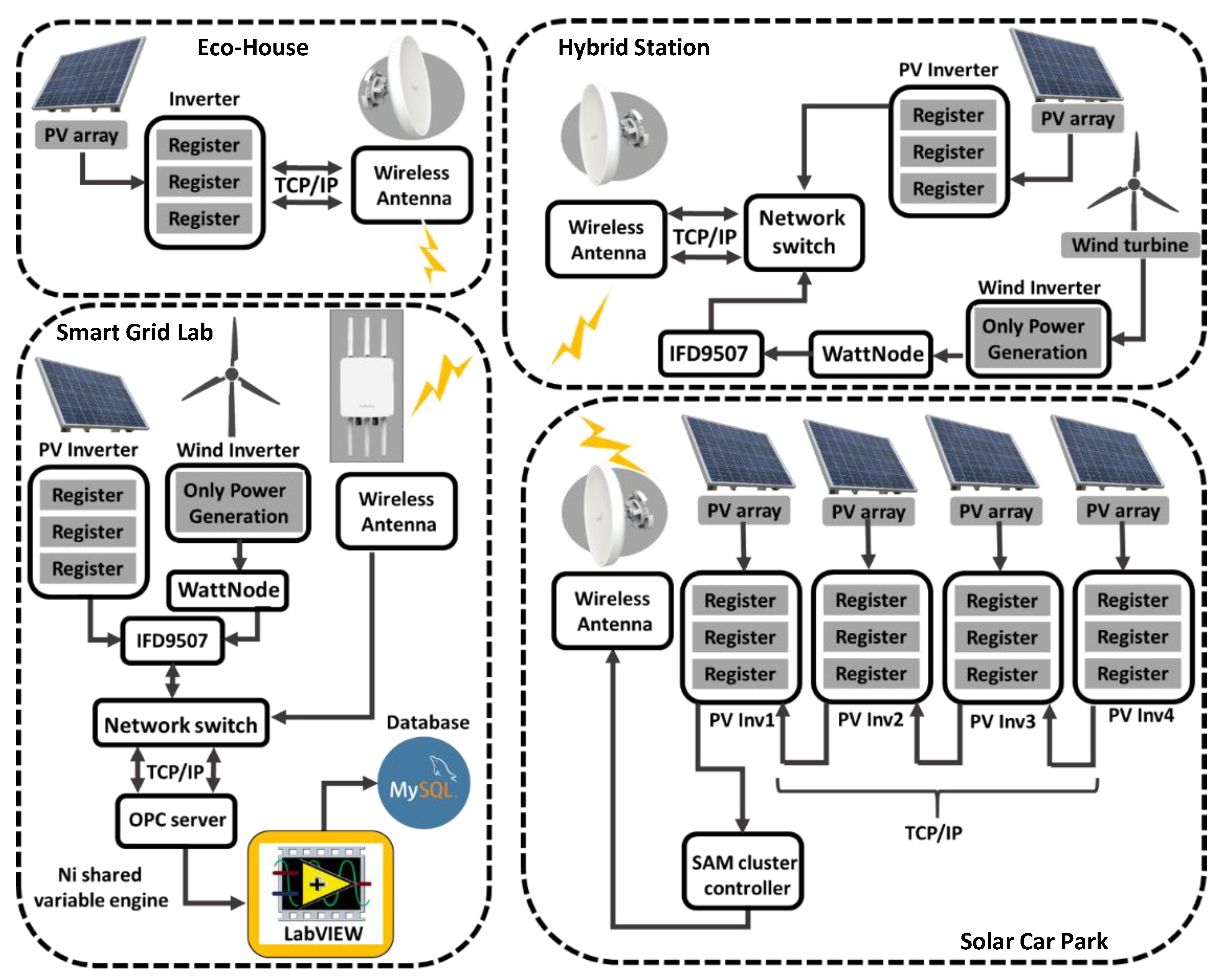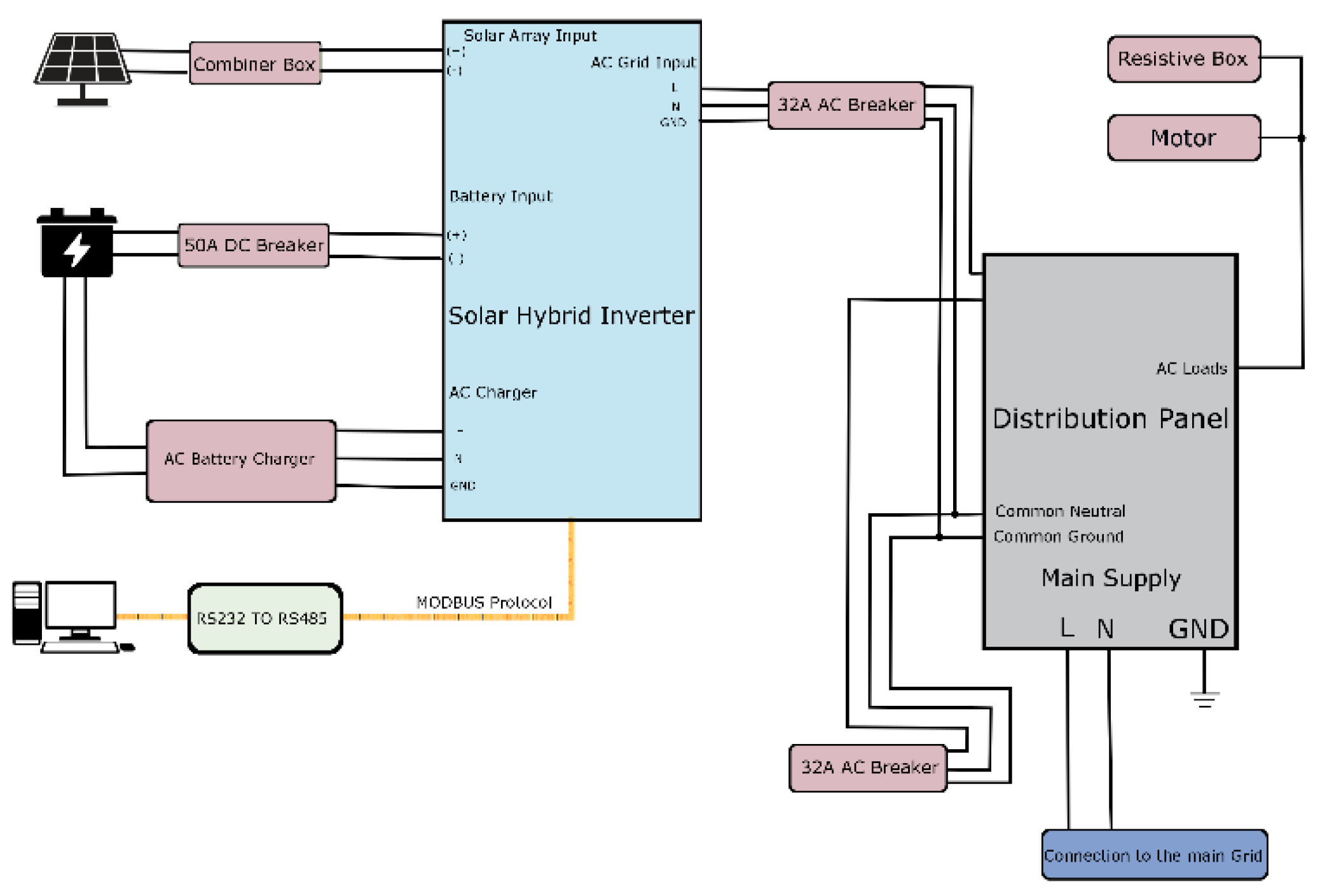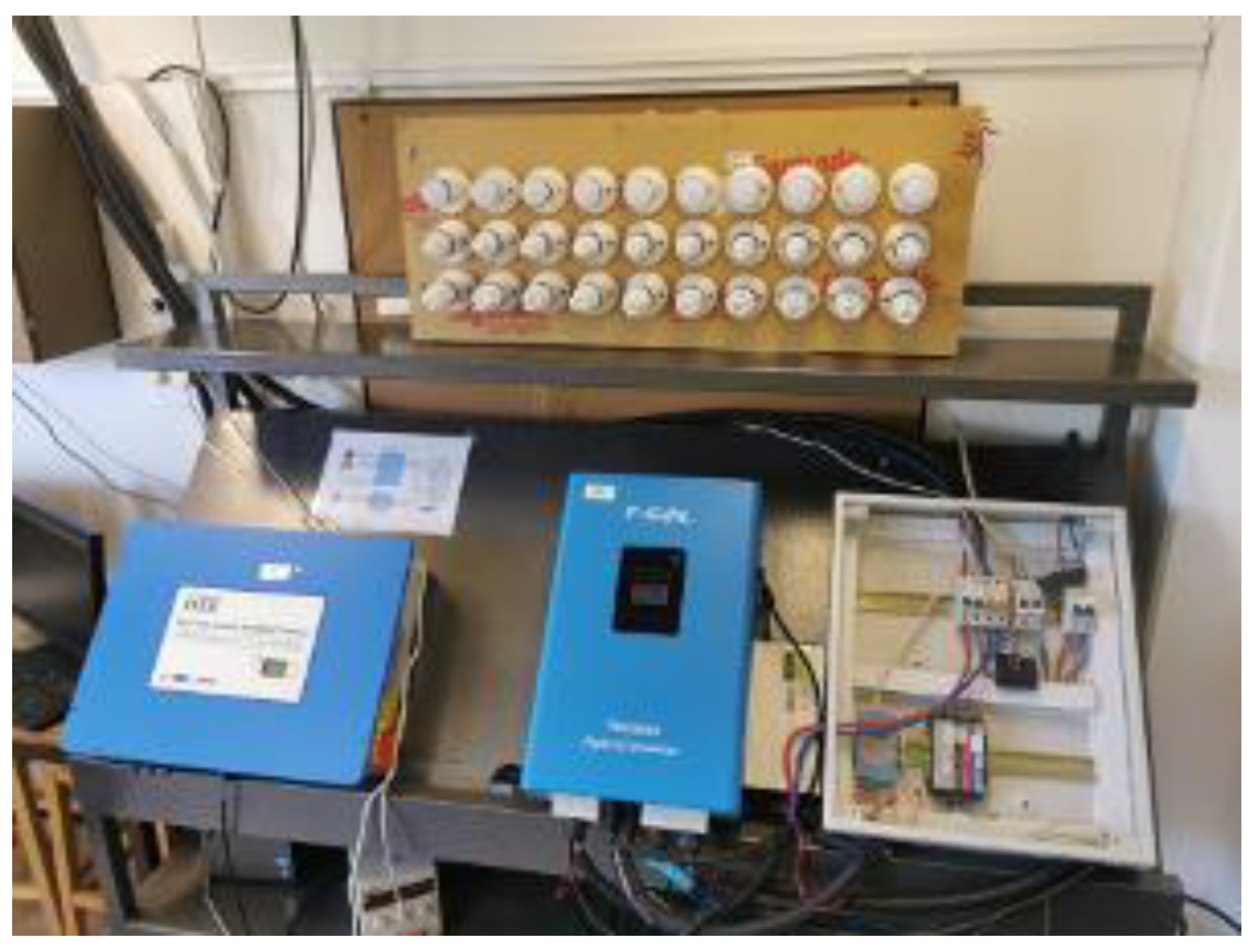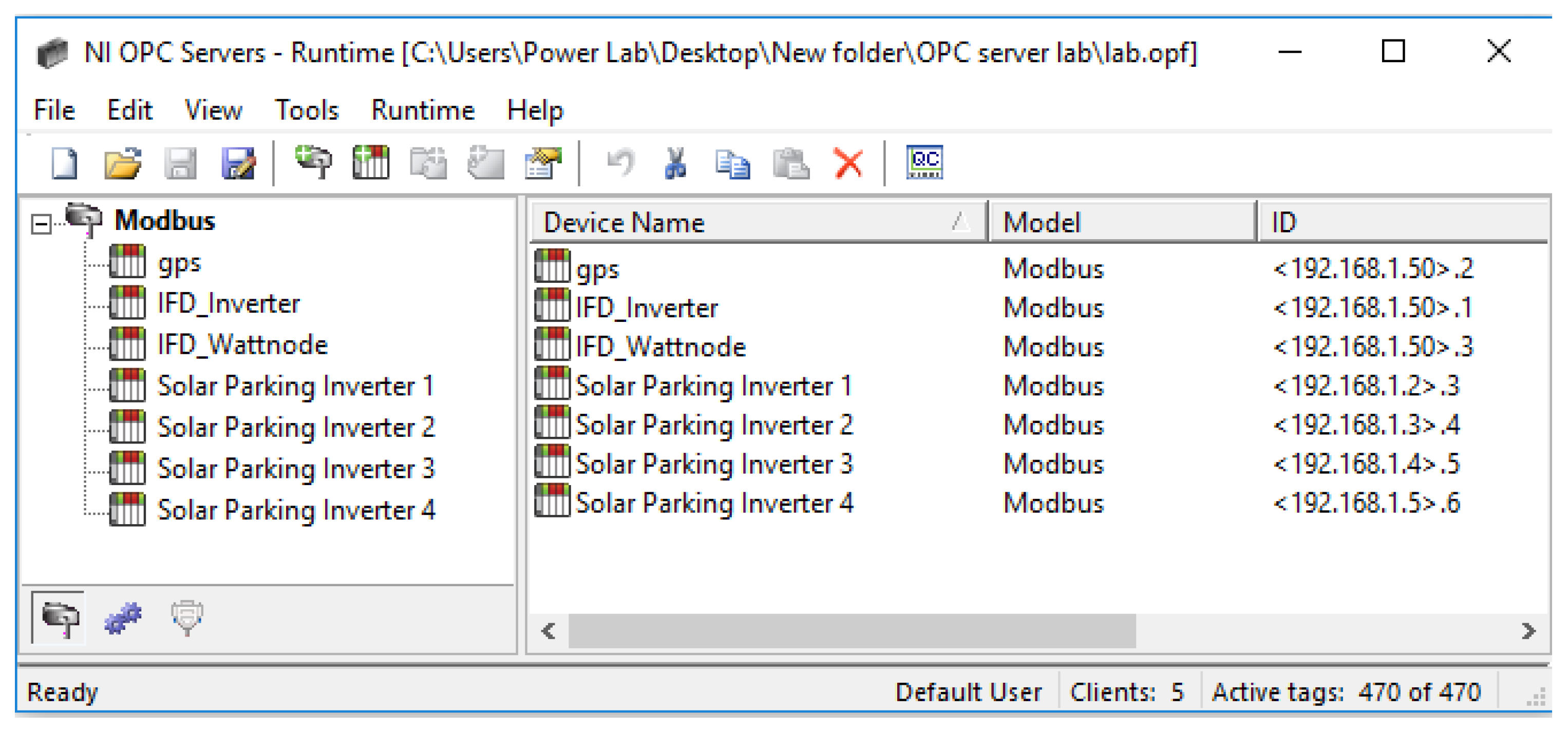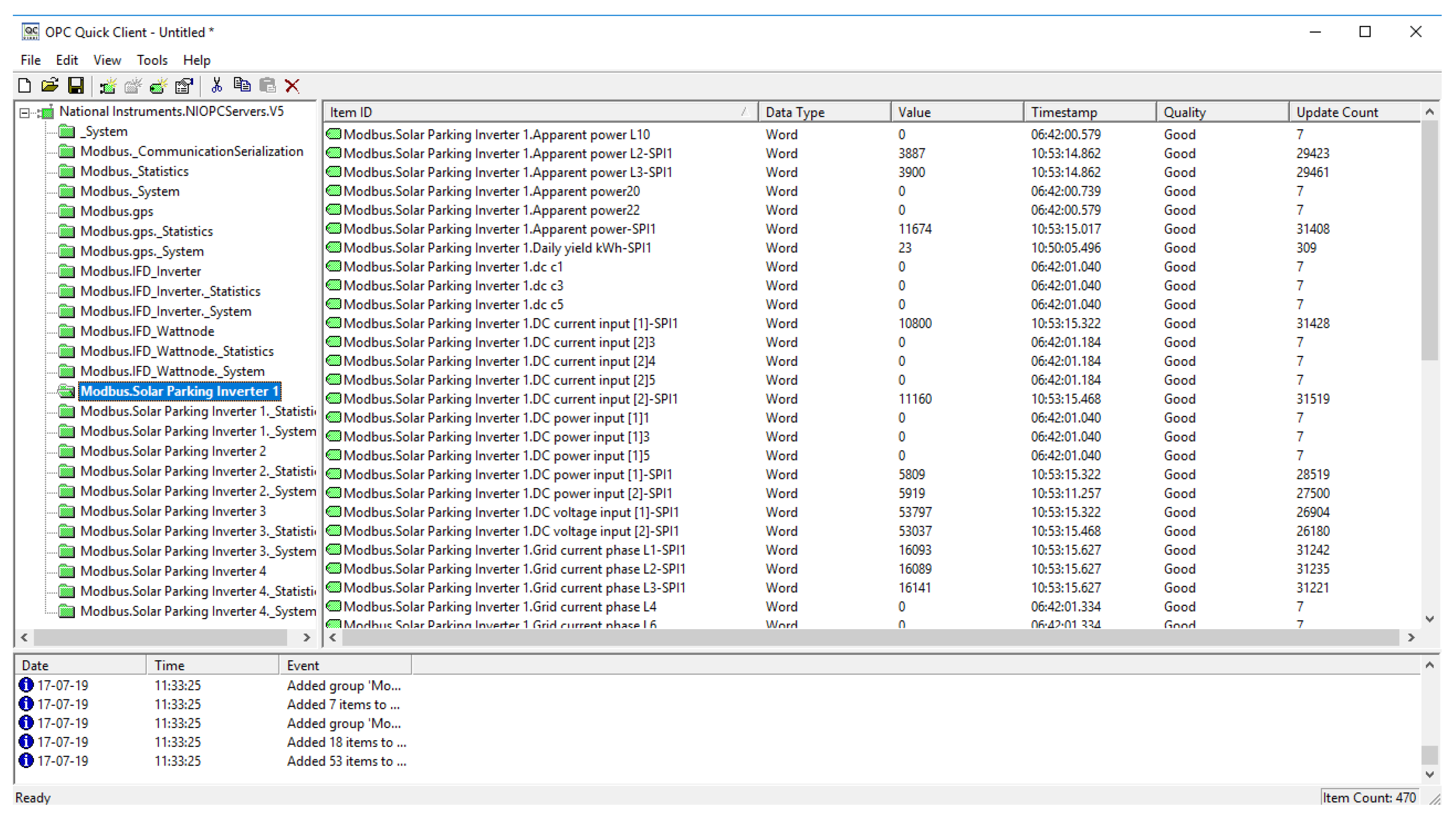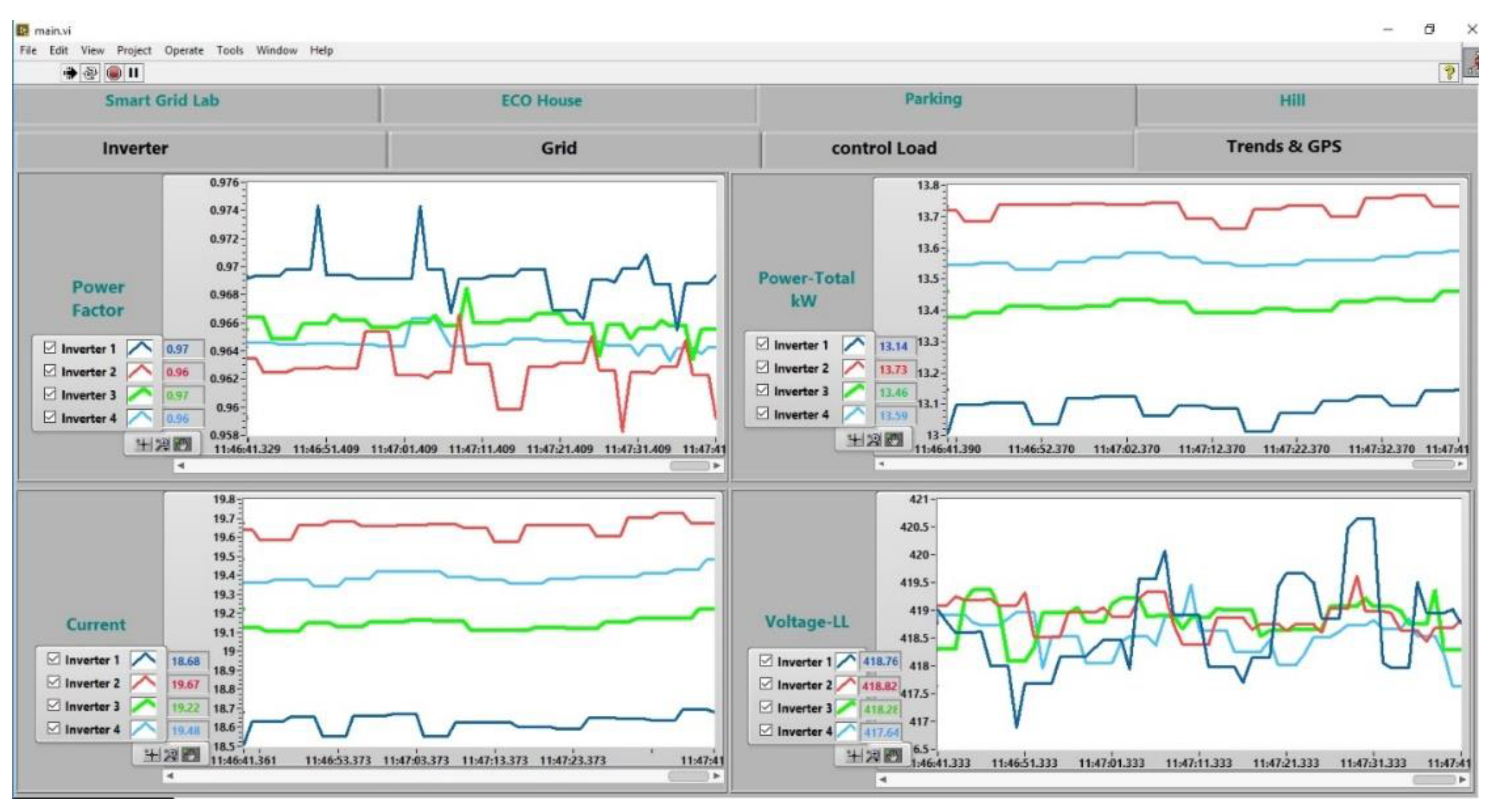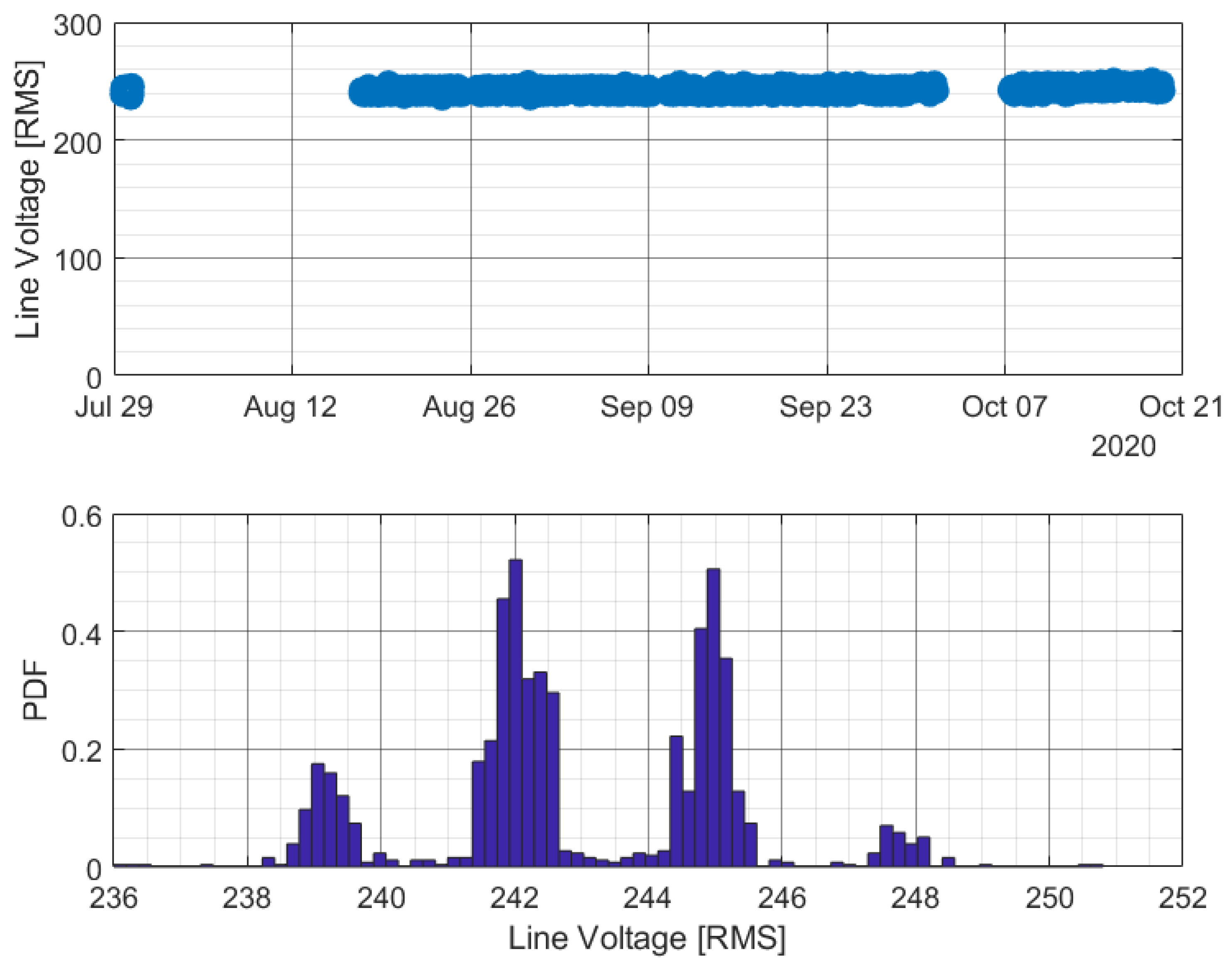1. Introduction
Renewable Energy Systems (RES) may be installed in a power grid in two forms. The first form is a centralized, large-size system, which is usually directly connected to the high-voltage grid. The second form is a decentralized, relatively small-size system that is connected to the distribution power network. In the second form, the distribution network is facing a large number of distributed prosumers, who at each instant of time can be either generating or consuming energy with a high level of variability. This problem necessitates developing platforms for real-time management of energy flow from these prosumers.
Smart grids have been developed to make the operation and planning of power systems more efficient and facilitate the management of RESs. A smart grid incorporates sensors and controllers to monitor the power system in real time and make automatic changes when required. Additionally, a smart grid incorporates various distributed energy resources (DERs), distributed computing, and communication networks for a bidirectional flow of data to balance power supply and demand while providing optimal socio-economic benefits [
1,
2]. The successful implementation of a smart grid requires participation and compatibility among various disciplines and technologies. Examples of such cross-disciplinary areas are as follows [
3]:
- (1)
Power Electronics: This is used for converting the available power from one form to another and to integrate various types of DERs with the grid. This ensures high power quality and energy efficiency [
4,
5].
- (2)
Power Systems: The power system must retain its ability to operate efficiently, remain stable, and isolate faults with faster service restoration. This requires conducting various studies that focus on achieving the balance between supply and demand, control systems, optimal network reconfiguration, contingency analysis, short-circuit analysis, stability analysis, and relay protection coordination [
6].
- (3)
Communications Networks: Bidirectional communication channels are essential to achieve advanced grid functionalities required for system operation, monitoring, pricing, and protection. It is necessary to digitally connect various power system stakeholders through communication links to achieve the required data flow [
7].
- (4)
Economics: One of the main objectives of deploying smart grids is to reduce the overall energy production cost while taking care of various rules and regulations for its promotion and power trading. As such, smart grids require various techno-economic analyses to be carried out [
8].
One type of platform that helps integrating distributed generators (DGs) into the distribution grid is the microgrid. A microgrid is a localized group of energy sources and loads with an embedded control scheme. The core idea of a microgrid is to collect a limited number of DGs, local loads, and possibly storage components into a single unit. The microgrid also integrates a local control for each DG unit and master control for the whole unit as it is connected to the power grid at a point of common coupling (PCC). The microgrid is equipped with distributed controls using the local information of a specific region, which enables DG units to be systematically integrated to ensure a reliable operation of the system [
9,
10]. A further step to integrate the DERs into the power grid without compromising the reliability and stability of the power system is the notion of a virtual power plant (VPP). The VPP coordinates all DERs, or multiple microgrids, in a single agent to make them behave as a single power plant at the PCC [
11].
Many types of monitoring technologies have been integrated with smart grid applications to provide real-time data for prosumers and power generation companies. One of these emerging technologies is the Internet of Things (IoT), which has become prominent in this area as it is easy to integrate and is generally cost-effective. The core of this technology is an embedded system capable of reading electrical parameters from sensors attached to the electrical system that relays these readings to a cloud server through a TCP/IP Internet connection. Cost-effective embedded systems such as ESP8266, a low-cost Wi-Fi microchip with a full TCP/IP stack and microcontroller capability, and ESP32, a system on a chip (SoC) series with Wi-Fi and dual-mode Bluetooth capabilities, are excellent solutions for Internet-based monitoring systems due to their ability to read analog voltage and current directly from compatible sensors and send the readings to cloud servers via integrated Wi-Fi modules [
12]. Web servers can also be deployed and integrated into such embedded systems to provide a local monitoring solution without an external internet connection [
13,
14,
15].
For large-scale distributed electrical generation systems, long-range wireless technology is an essential requirement. Despite all the attractive features of IoT technology, such systems are very limited in terms of coverage range as well as throughput and can only be used for sending limited amounts of data. The range of IoT devices can be extended to a few kilometers by using long-range wireless technologies such as LoRaWAN [
16]. Another possibility to overcome range limitations is to deploy IoT nodes in a private network with a star topology in which a local gateway is responsible for relaying nodes’ data to a remote server using any wireless technology supporting TCP/IP connection. Nevertheless, IoT has been developed targeting low-throughput applications in which required physical parameters to be measured are varying slowly with time such as temperature, humidity, etc. In contrast, smart grid systems are generally dynamic and could have a large swing in power outputs within a few seconds, which requires drastically different systems to monitor and log such changes.
Another approach for smart grid monitoring is the use of Data Acquisition Units (DAQ). These are small electronic devices designed to collect and send data to a processing unit they are physically attached to. The processing unit is responsible for data collection, visualization, analysis, and possible data transfer to external destinations using different communication protocols [
17]. Unlike IoT, DAQs are much faster because they are not designed to relay data beyond the processing unit. The utilization of DAQs in monitoring systems for smart grids has been widely exploited in the literature [
18,
19,
20]. National Instruments has been a key player in this area with industry-grade DAQs, coupled with the LabVIEW platform, which supports a plethora of communication protocols as well as data visualization and analysis tools. Nevertheless, DAQs are not always practical to use in monitoring applications since they are required to be physically close to the processing unit they are attached to. In some instances, DAQs may require continuous calibration especially in some environments where there is a change in operating temperature, humidity, and pressure.
A more flexible solution for smart grid monitoring is the use of smart meters. This technology has been around for several years and has been incorporated mostly by utility companies for billing purposes as well as the management and optimization of energy distribution to consumers [
21,
22]. Electricity distribution companies are widely using smart meter technology for demand management and demand response through time-of-use tariffs [
23]. Smart meters typically send the acquired data through existing wireless communication infrastructure such as 3G, 4G, 5G, WiMAX, WLAN, and LoRaWAN [
24,
25]. Smart meter technology is similar to IoT in terms of compactness, ease of installation, and reliance on existing wireless infrastructure. However, unlike IoT, smart meters are customized toward electrical consumption and fault detection.
At the heart of the smart grid system is the inverter, which is responsible for connecting renewable energy sources to the grid. Manufacturers of hybrid inverters have been overwhelmingly moving toward integrating various monitoring systems into their products; enabling consumers and utility companies to gather consumption and operation parameters directly from these inverters without the need for additional devices. Companies such as SMA are well known for their provision of various products, which are shipped with multiple monitoring systems including integrated web servers, web portals, and a MODBUS interface as well as proprietary protocols designed specifically for integration with compatible products [
26,
27]. These proprietary protocols and software are restrictive when integrated into a large-scale system containing components from different manufacturers. Interoperability is always an issue in such systems; therefore, it is always desirable to select inverters supporting common communication protocols and interfaces. Possible system expansion and large variation of technologies may require opting for complete integration of devices using different communication protocols.
With the sheer number of available technologies utilized to monitor smart grid performance, some scenarios may arise in which mixing some of these technologies is inevitable. Several systems have been proposed to integrate many technologies for monitoring the performance of smart grids [
28,
29,
30]. Most of these systems are based on using a common communication protocol to collect data from all products into a centralized node or cloud servers. In [
31], a real-time power flow monitoring system is proposed, which uses the existing SCADA of a medium voltage distribution network and adds to it new measuring devices and a capillary communication system to connect the control center to all field power quality analyzers. In [
32], a real-time monitoring of a microgrid is proposed that uses distributed cloud–fog architecture. It has three layers: namely, a device layer, fog layer, and cloud layer. Basically, it communicates device layer information over the Internet. Furthermore, González et al. [
33] presents a remote monitoring platform for an experimental microgrid. There are some similarities between this research work and what is presented here in terms of using LabVIEW program and an Open Platform Communications (OPC) interface, but the architectures used are different. This article proposes a monitoring system for smart grids in which all elements of the system are connected to a central server by long-range bridged WLAN. Inverters, smart meters, and controllable loads can use different communication protocols and still be able to relay information to the central server. While the proposed system uses MODBUS over TCP connection as a backbone communication protocol, it is capable of supporting other standard protocols simultaneously. The ability to support many other protocols makes the proposed system very scalable and modular, and it facilitates the interoperability of various types of inverters.
The rest of this paper is structured as follows.
Section 2 describes the DERs under study and the components that were introduced to them to have a real-time monitoring platform. This is followed by a discussion of the implementation of the platform in
Section 3. The platform is driven by a stack of software, where its architecture is presented in
Section 4. The results are discussed in
Section 5, while concluding remarks and future extensions are highlighted in
Section 6.
2. The Distributed Energy Resources
This section describes the DERs used in this study, where we develop a customized real-time platform for monitoring assets in those DERs. The platform uses a secure wireless bidirectional communication channel. However, while a small-scale DER system is used, the platform is designed in a way to make it expandable for larger systems in the field. The small-scale DERs consist of four standalone renewable energy systems located at the Sultan Qaboos University campus, Sultanate of Oman (see
Figure 1). The figure shows four RESs that are located within a few kilometers from each other. These RESs are (1) Smart Grid Lab, (2) Solar Car Park, (3) Eco-House, and (4) Hybrid Station. Each RES generates a different amount of electrical energy depending on the number of installed solar panels and wind turbines. The amount of generated power from each RES is annotated in the figure.
The combined power production from all RESs is roughly close to 50 kW at the peak hour. All RESs are linked by a high-speed IEEE 802.11n wireless link facilitating data transfer to a central server for data storage, analysis, and visualization.
Each RES is equipped with a monitoring system, as shown in
Figure 2. The figure shows a general architecture of a real-time monitoring system within a building. The aim is to make the monitoring system interoperable so that it can receive data from different devices. The energy system shown in the figure consists of solar panels, wind turbines, storage batteries, one or more inverters, smart meters, and an optional weather station. The monitoring system is used for collecting and logging data from these components. The following subsections discuss the components of the RES and the monitoring system.
2.1. Inverters
There are two different categories of inverters deployed in this system; namely, solar and wind inverters. Solar inverters are installed at the four locations, whereas wind inverters only exist at the Smart Grid Lab and the Hybrid Station. The following subsections detail the inverters used at each location.
2.1.1. Smart Grid Lab Inverters
The inverter used in this station for the solar system is the T-SOL TEM3000. This hybrid inverter is capable of producing a maximum AC power of up to 3 kW. The inputs of the inverter are connected to an array of solar panels at the rooftop of the College of Engineering (East Building). On the second floor of the building, storage batteries are connected in parallel to the battery input of the inverter on the ground floor. The inverter has an AC output to charge the batteries—another output for off-grid loads—and a direct connection through a circuit breaker to the grid. The inverter uses the Modbus RS485 protocol for data extraction, which is not compliant with Modbus-TCP/IP. Therefore, a serial-to-Ethernet converter (Delta, IFD9507) was used to convert Modbus-RS485 to Modbus-TCP/IP and provide a standard interface to the system. The serial-to-Ethernet converter is connected to the central server using a standard Ethernet cable to enable the server to extract and store all necessary information from the inverter. Since the manufacturer of the inverter did not include the corresponding Modbus registers addresses for the electrical parameters, the addresses were reverse-engineered by comparing the data extracted at random address with the data displayed on the integrated screen of the inverter.
As for the wind turbine at this location, the HYGCL-15-V1.5 inverter is capable of producing a maximum of 1.6 kW to the grid. Since this inverter does not support any common communication protocol, it was necessary to use smart meters (WattNode WNC-3Y-400-MB) to measure the produced power, which is fed to the grid.
2.1.2. Solar Car Park Inverters
The Solar Car Park contains four SMA STP20000TL inverters. Each inverter is capable of outputting a maximum of 20 kW of power to the grid. All inverters are equipped with Modbus TCP/IP service exposing all electrical parameters through a standard TCP/IP connection. The four inverters are daisy-chained and connected to a complaint cluster controller. This cluster controller contains an integrated network switch, which provides an easy mechanism to connect to each inverter using a unique IP address. The cluster controller is wirelessly bridged to the server located at the Smart Grid Lab using IEEE802.11n wireless connection. This allows the server to query the stored electrical parameters from each inverter.
2.1.3. Eco House Inverters
Similar to the Solar Car Park station, the Eco-House location was equipped with the same inverter. The solar panels, which are installed at the rooftop of the Eco-House, are connected to the solar inverter. The output of the inverter is fed directly to the grid, and the electrical parameters are exposed through a standard TCP/IP connection to a central router inside the building.
2.1.4. Hybrid Station Inverters
The Hybrid Station is equipped with the InfiniSolar V inverter, where the latter can produce a maximum AC power of 5 kW. The inverter has two DC input terminals: one for solar panels and the other for batteries. The output of the inverter can feed the grid directly with the addition of an off-grid terminal enabling the inverter to power small loads in the absence of grid power. One drawback of this inverter is that it does not support Modbus protocol by default, and an extension card is required to provide Modbus access. Therefore, a smart meter was installed at the AC output of the inverter to measure the power sent to the grid.
Similar to the Smart Grid Lab, the Hybrid Station is equipped with the HYGCL-15-V1.5 inverter along with the WattNode WNC-3Y-400-MB smart meter.
2.2. Energy Storage System
Both Smart Grid Lab and Hybrid Station DERs host battery storage systems. The battery system provides power backup for appliances in case of a power outage from the utility. It can be used for other purposes such as peak load shifting or peak load shaving in more sophisticated systems.
Figure 3 shows the battery storage system at the Smart Grid Lab. The storage system consists of 24 12-Volt batteries, each capable of storing 200 AH of electrical energy.
In contrast,
Figure 4 shows the storage system used at the hybrid station, which consists of eight 12-Volt batteries.
2.3. Smart Meters
The WattNode WNC-3Y-400-MB, shown in
Figure 5, is used as the smart meter for all DERs. This type of metering device was chosen for its rich features and mainly for its support of the Modbus protocol. It can measure the electrical parameters of three different phases simultaneously and provides the readings through the standard Modbus interface. However, WattNode does not support TCP/IP protocol. Therefore, a protocol converter is required to be able to integrate it into the system.
The WattNode metering device is used in two configurations in different DERs in the developed system. The first configuration is at the Smart Grid Lab, where the WattNode is connected to the serial port of the main server via RS232-to-RS485 converter as seen in
Figure 6. In this case, a TCP/IP connection is not required as the server has direct access to the WattNode through the integrated serial port.
The second configuration is at the Hybrid Station in which the WattNode is connected to the server through an RS485-to-TCP/IP converter. This is required, since the Hybrid Station is remotely connected to the main server. Therefore, a wireless TCP/IP connection is required to facilitate a remote parameter acquisition.
2.4. Protocol Converters
Generally speaking, meters that lack a TCP/IP interface require a protocol converter that allows those meters to access the network.
Figure 7 shows the IFD9507 converter, which is capable of converting Modbus RS485 to Modbus TCP/IP; making it possible to query and extract Modbus registers through a standard TCP/IP connection.
2.5. Wireless Communication System
To establish a real-time monitoring system, the communication technology used must have a high data rate, support for long-range communication, and a relatively long operating life. This has led to choose the IEEE802.11n standard, which meets all the aforementioned requirements and has long been used in industry with high effectiveness. Although the range of communication technologies depends on the power of the antenna to a high extent, all possible ranges of this standard are suitable for the proposed platform.
The system consists of a central access point—connected to the main server—and several wireless clients connecting remote stations to the central access point. All wireless devices are mounted at the rooftops of the DERs to provide unobstructed line of sight (LOS) connectivity. These devices are configured to operate in the 5 GHz band to avoid possible interference with the existing wireless network operating at 2.4 GHz.
The EnGenius ENH 1750EXT access point was installed at the rooftop of the Smart Grid Lab. This access point can communicate with a maximum of eight other wireless clients. The antennas that are connected to this device have an omnidirectional radiation pattern and consequently low radiation gain. This permits the reception of wireless signals from all directions equally. This is an essential requirement as other locations are spatially oriented at different angles.
High-gain antennas (EnStation5 EN300) with long-range communication were installed on all other DERs (i.e., Solar Car Park, Eco-House, and Hybrid Station). Due to the high directivity of these antennas, they had to be oriented to point directly toward the access point for the maximum signal to be received. Calibration and orientation adjustments were carried out for each device to ensure a reliable connection.
5. Discussion of Results
The performance of the whole system in terms of power generation was evaluated during the first three quarters of the calendar year 2020.
Table 1 illustrates the recorded data from the monitoring platform for some specific quantities during the first quarter of the year 2020. During this period, the Solar Car Park generated a daily combined average of 12.4 kW from all four inverters. The generated electrical energy from the station in the first quarter was 26.8 MWh, accounting for more than 75% of the energy generated from all stations. The Eco-House produced a daily average of 3.7 kW of power and 8 MWh of energy in the first quarter of 2020, accounting for 23% of the energy generated from all stations in that period. The least amount of power and energy was generated by the Smart Grid Lab with a daily average power of 203 W and generated energy of 0.44 MWh. The amount of generated energy was roughly 2% of all stations. The reason for the low generation capacity is that the lab is only used for research purposes and not for consumption by actual loads. The Hybrid Station was not commissioned until the end of August 2020. Therefore, it is not accounted for any power and energy generated within this period.
The data for the second and third quarters of the year 2020 are also recorded. Quarter 2 witnessed an increase in power production due to the increase in solar radiation in this period of the year. The amount of increase is around 25% of the values generated in the first quarter.
The daily average power generated at the Solar Car Park is 15.6 kW, reaching a peak of 51.3 kW during the afternoon hours. The generated energy in the second quarter of the year 2020 was about 33.7 MWh, accounting for 98.5% of the total energy production for all stations. This large percentage is attributed to the Eco-House station being out of service, and the Hybrid Station is not yet operational at that time.
The Smart Grid Lab station produced a daily average power of 251 W and a generated energy of 0.54 MWh accounting for only 1.5% of power production from all stations.
The third quarter of the year 2020 includes data from the Hybrid Station, as it was commissioned at the end of August 2020. In Quarter 3, a slight decrease in power production is observed compared with the second quarter of the year 2020. This decrease is attributed to reduced solar radiation due to the seasonal motion of western winds carrying a large amount of dust in the atmosphere; thereby reducing the generated power. Average power generation from the Smart Grid station has decreased by 7%, while power generated at the Solar Car Park station decreased by 8%.
The Solar Car Park has a daily average power generation of about 14.4 kW with an aggregate generated energy of 31.1 MWh in the third quarter. This accounts for 95% of all energy generated by all stations.
The Smart Grid Lab accounted for 1.5% energy generation in the third quarter with 0.5 MWh and a daily average power of 232 W.
The Hybrid Station generated a daily average of 265 W with a peak of 1.7 kW during the afternoon and an aggregated energy of 1.2 MWh in the third quarter. This accounted for 3.5% of all stations’ energy generation.
It is worth mentioning here that the measured data were set to a common time frame to compare DER’s contribution to the grid. Synchronized measured data were recorded during September 2020.
Figure 21 shows the recorded line-to-neutral voltage at the point of common coupling and its distribution at the hybrid station. The system was off during some periods of time due to some inverter disconnections. The figure clearly shows that the voltage is fluctuating within an acceptable range of ≈10 V
rms around a mean value of 243 V
rms from measured data. More specifically, the calculated standard deviation of the line voltage from measurements is ≈2 V
rms.
Figure 22 demonstrates the battery charging/discharging current, the output power generated by the PV system solar panels, and the inverter output power. The data were collected at intervals of 15 min. During the daytime, the solar panel is supplied the load power and charging the battery, while during night time, the battery is discharging power as expected. Similarly, a display of the recorded data from the Hybrid Station and the four inverters used at the Solar Car Park is shown in
Figure 23 during the second half of September.
6. Conclusions
This paper presents an implementation of integrated distributed energy systems with the power grid using inverter-based distributed renewable energy resources (DERs). The management of DERs is carried out in real time using different communication technologies. A testbed was implemented at Sultan Qaboos University in Oman, where four DERs were grid-connected to the LV network of SQU. The testbed is capable of online monitoring DERs where field-proven results show that DERs controllers can support the smart grid energy management system based on different modes of operation and configuration settings under varying power system conditions. The prototype can be extended to include more control functions and peer–peer communications. This will pave the road to an advanced smart microgrid implementation in the power system.
The real-time monitoring platform is fed by a customized two-way secured communication channel between the microgrids and the control center using a long-range bridged wireless local area network (WLAN). For displaying information in various forms, a dashboard is developed that shows real-time measurements from the DERs. The proposed system is scalable, modular, facilitates the interoperability of various types of inverters, and communicates data over a secure communication channel.
The developed system can be extended to perform control and protection actions. This requires the use of a more accurate GPS clock for network-wide synchronization and the use of higher sampling to capture fast transients. Increasing the sampling rate will lead to a huge amount of electrical parameter data being sent to the central station from all nodes. Hence, constraints due to storage limitations should be considered. On the other hand, although the used communication technology in the developed system is working as needed for monitoring, however, other communication technology options should be investigated to ensure scalability and security of the system. To include monitoring of the microgrid protection system, the controllers of the DERs need to be connected to circuit breaker auxiliary contacts and instrument transformer secondary, tripping, and closing circuits of the circuit breaker.
